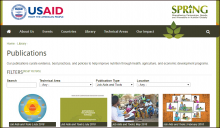Thinking and Working Politically Through Applied Political Economy Analysis: A Guide for Practitioners
This guide provides information on how USAID can think and work in ways that are more politically aware, an approach known as “thinking and working politically” (TWP), through the use of Political Economy Analysis (PEA). PEA is a structured approach to examining power dynamics and economic and social forces that influence development. PEA can help to operationalize the process of thinking politically, while USAID’s initiative on Collaborating, Learning and Adapting (CLA), supports the operationalization of working politically. Together, they can add significant value to a mission’s strategy, projects and activities.
Sectors
Democracy, Rights & Governance










